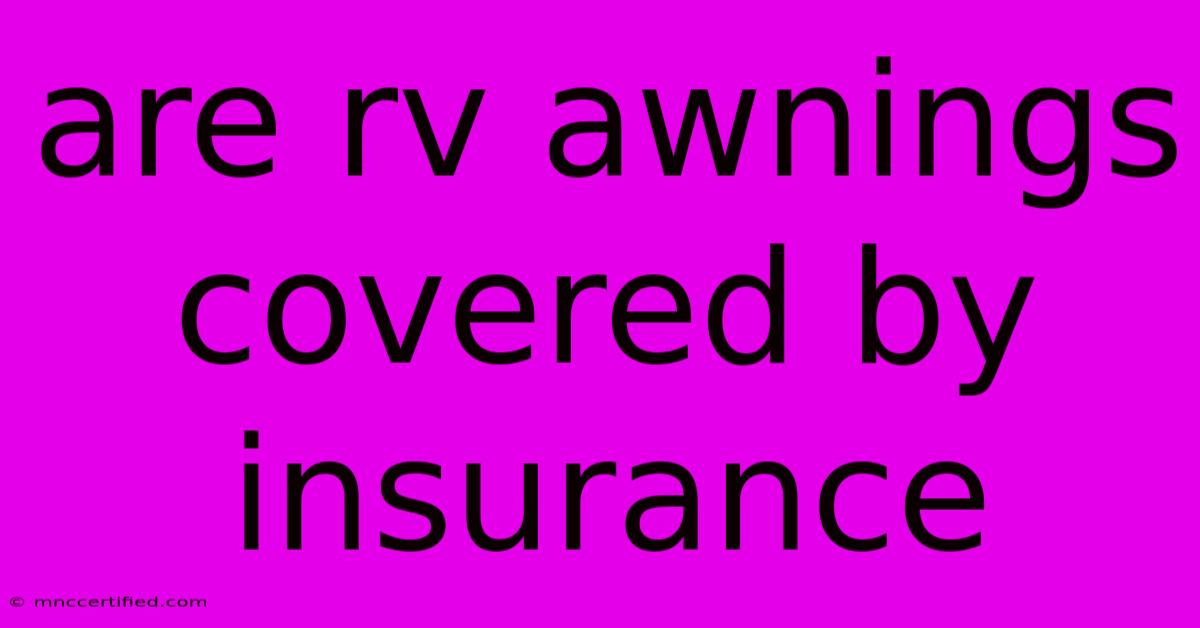Are Rv Awnings Covered By Insurance

Table of Contents
Are RV Awnings Covered by Insurance? A Comprehensive Guide
Your RV awning provides shade, shelter, and a sense of home while you're on the road. But what happens if it gets damaged? Are RV awnings covered by insurance? The answer, unfortunately, isn't always a simple yes or no.
Here's what you need to know about RV awning insurance coverage:
Understanding Your RV Insurance Policy
The first step is to carefully review your RV insurance policy. Look for sections related to "personal property coverage," "comprehensive coverage," or "specified perils coverage." These sections often outline what is and isn't covered in case of damage or loss.
Key Factors Affecting Coverage:
- Type of Damage: Your insurance provider will consider how the awning was damaged. Wind damage, hail damage, and theft are generally covered under comprehensive coverage. However, damage caused by normal wear and tear, improper maintenance, or accidents may not be.
- Policy Deductible: Remember that you'll likely have to pay a deductible before your insurance kicks in. Make sure you understand this amount to avoid unexpected costs.
- Insurance Provider: Different insurance companies have varying coverage policies. Some may offer optional add-ons for enhanced awning protection, while others may have stricter limitations.
Common Exclusions:
- Wear and tear: As with any part of your RV, normal wear and tear is usually not covered.
- Improper maintenance: If the damage was caused by neglecting maintenance, like failing to retract the awning during high winds, insurance might not cover it.
- Accidental damage: Accidents, such as bumping the awning against a tree or vehicle, may not be covered.
Tips for Maximizing Coverage
- Get a detailed inventory: Keep a detailed record of your RV's accessories, including the awning, its make, model, and purchase date. This can help with claiming in case of damage.
- Consider additional coverage: Check if your insurance company offers optional add-ons that specifically protect awnings. These might include coverage for accidental damage, wear and tear, or even replacement costs.
- Maintain your awning: Proper maintenance is crucial. Clean your awning regularly, lubricate moving parts, and retract it during high winds.
In Conclusion:
Whether your RV awning is covered by insurance depends on several factors, including the cause of the damage, your policy, and your insurance provider. By thoroughly reviewing your policy, understanding the common exclusions, and taking preventive measures, you can increase the likelihood of having your awning covered in case of damage. Remember, communication is key! Reach out to your insurance agent with any questions and discuss your coverage options to ensure you're well-protected.

Thank you for visiting our website wich cover about Are Rv Awnings Covered By Insurance. We hope the information provided has been useful to you. Feel free to contact us if you have any questions or need further assistance. See you next time and dont miss to bookmark.
Featured Posts
-
Free Live Stream Hawks Vs Celtics Nba Cup
Nov 13, 2024
-
See The November Supermoon Timing And Tips
Nov 13, 2024
-
Homeowners Insurance Naples Florida
Nov 13, 2024
-
Ecuador Mourns Marco Angulo 22 Footballer
Nov 13, 2024
-
State Pensioners Urgent Message About Crisp Packets
Nov 13, 2024